
AI Reducing Healthcare Costs: Real Savings Backed by 7 Startup Case Studies
Look at the real numbers from healthcare organizations that show AI reducing healthcare costs in real. The AI lens makes costs look controllable.
Continue Reading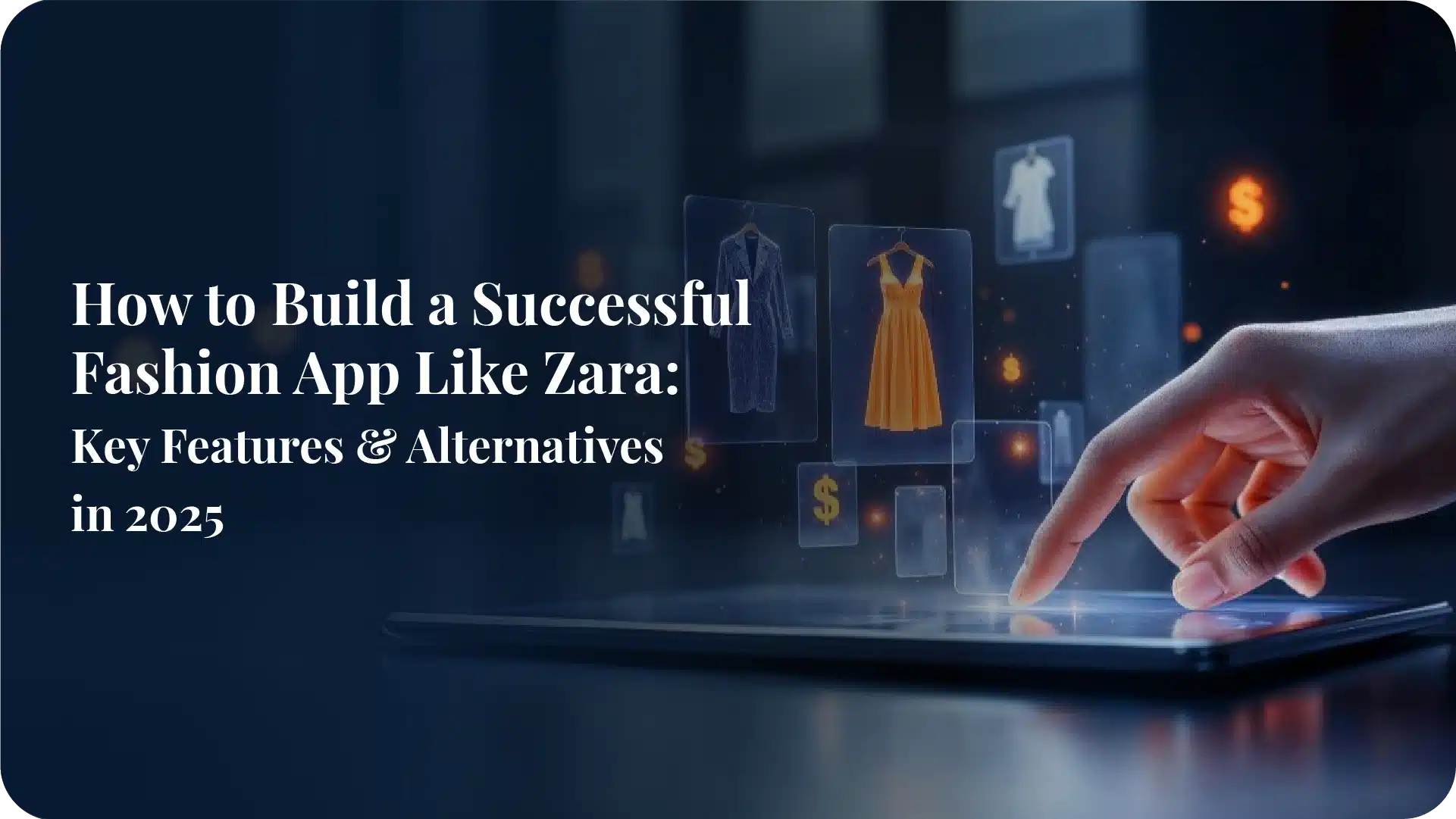
The mobile commerce industry is expected to account for 75% of total e-commerce sales, based on its current growth trajectory. The fashion app development industry is a key driver of this anticipated market expansion. Zara has achieved dominance in mobile commerce, surpassing all other fashion retail apps, due to its fashion model that efficiently accelerates product design, production, and trend distribution.
The blog examines the Zara app’s success factors, followed by fashion app development requirements, future fashion trends, and market challenges for 2025. Developers, Fashion enthusiasts, and business owners – can use this guide to develop fashion apps that will also be relevant in the future.
By 2025, it is anticipated that the fashion app market will have grown exponentially due to the rapid adoption of mobile commerce apps and the rising demand for seamless shopping experiences. As consumers shift to digital platforms, the fashion industry uses fashion app development to remain competitive and meet evolving consumer demands. The success of Zara’s app development and the growth of mobile commerce will be covered in this section.
Because consumers prefer the convenience of smartphone shopping, the fashion industry now heavily depends on mobile commerce apps. The mobile commerce marketplace worldwide reached USD 1,836.3 billion in 2024. The market projection by IMARC Group indicates that mobile commerce will reach USD 14,008.5 billion in 2033 while posting a 25.3% compound annual growth rate (CAGR) from 2025 until 2033.
The way that consumers behave has been profoundly altered by mobile apps. Customers can now use one-touch payment systems instead of standing in line at cash counters to pay their bills. Finding products used to require them to visit several stores, but now they can browse a large selection with a single click. In addition, they get tailored suggestions according to their location or shopping behavior. All of these features are facilitated by fashion retail apps.
For new and emerging designers, it is important to buzz your incoming collection. Apps for mobile commerce offer a way to connect with people around the world. You can enhance customer interaction by implementing features like wishlists, comprehensive product catalogs, and exclusive discounts and promotions. Shopping ethically and sustainably.
Consumers now favor mobile commerce apps that emphasize ethical and sustainable practices such as recyclable packaging,g carbon-neutral shipping choices, fair labor practices, and supply chain management that incorporates responsible sourcing. To draw these customers to their brand, businesses need to implement sustainable practices.
A lot of work goes into making the Zara app a smooth user experience. The Zara app’s user interface is simple to use, making navigation simple. Utilizing data analytics, they also tailor suggestions according to user behavior and past purchases.
AR virtual try-on enables users to see how their selected items might look on them in the future. The algorithm-based technology helps the app remain responsive and efficient.
Real-time stock availability, which reduces customer annoyance and increases trust,t is a key element of the Zara app’s success.
Zara’s omnichannel strategy enables features like click and collect for example, you can choose your product in an online app but receive it through a nearby physical store.
The success of the Zara app has prompted other brands to invest in retail app development, focusing on user-centric features and cutting-edge technologies.
Fashion app development must provide a smooth, interesting, and customized shopping experience in the cutthroat industry. The following are essential characteristics of a premium fashion retail app.
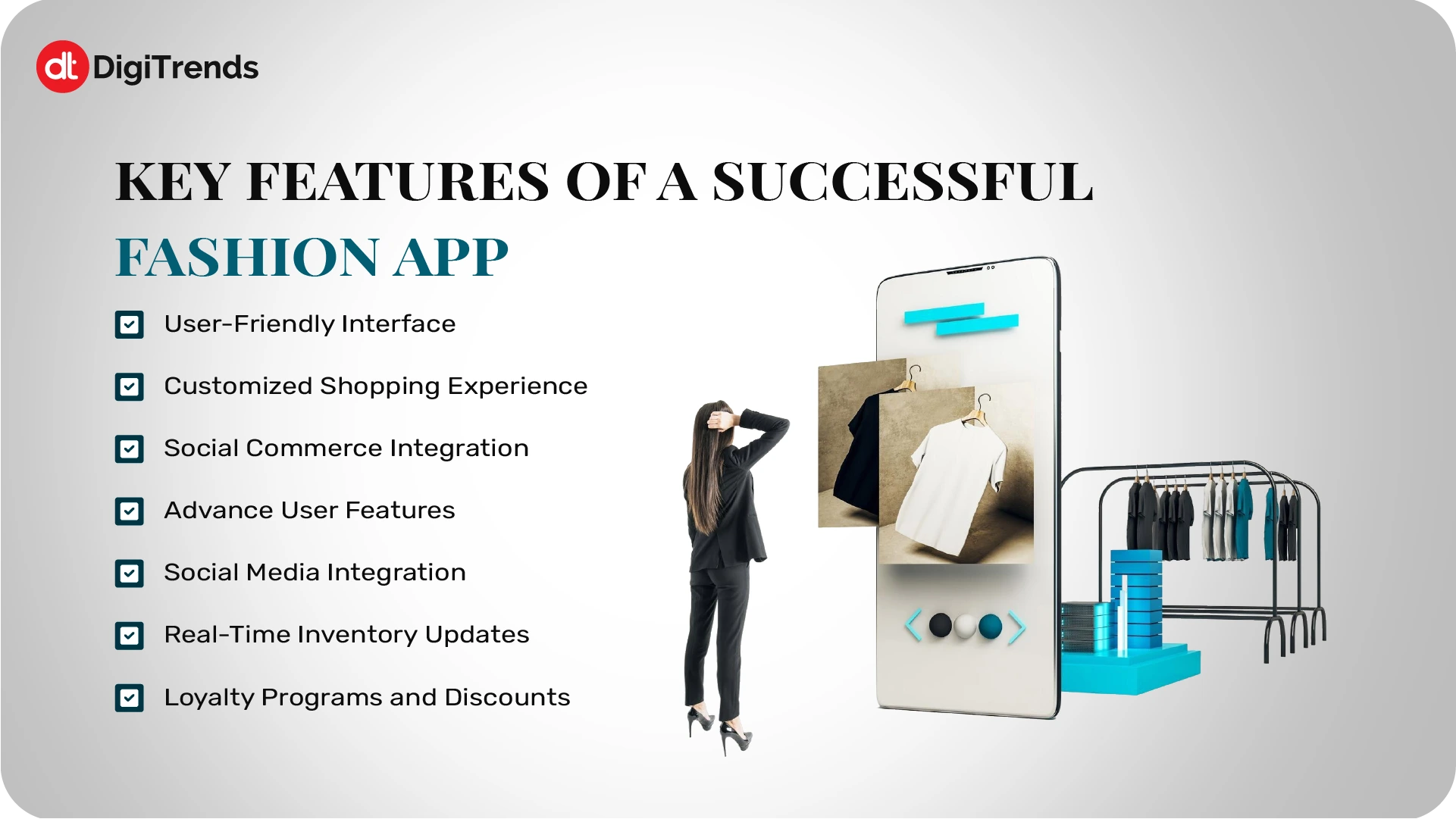
Simple and easy-to-use interfaces are undoubtedly preferred by users.
Because of its straightforward, rd minimalistic design, users can easily navigate the app. Search bars that are easily accessible, menus that are easy to understand, and basic product categories are crucial in this context.
Quick load times and optimized performance reduce user annoyance and increase retention rates.
When you are making a fashion app, you are not only targeting mobile users your app should be compatible with various devices.
To accommodate all users, including those with disabilities, include features like voice commands, larger fonts, and color contrast options.
By leveraging AI, consumers can get product suggestions that are tailored to the user’s behavior, preferences, previous browsing history, or prior purchases.
Depending on the user’s interest, show tailored banners, deals, and product highlights.
Give customers the option to save items for later to improve their shopping experience.
Send customized promotions like discounts on previously viewed items via emails or push notifications.
Enable multiple payment options like cash, credit cards, debit cards, mobile wallets, and other payment options so consumers can choose their preferred payment method.
The checkout process should be simplified. There is no need to gain excessive information at this stage.
Implementation of encryption technology allows to safeguard the sensitive data like credit card numbers.
Allow transactions in a variety of currencies to cater to clients from around the world.
Leveraging AR technology enables customers to virtually try on apparel clothing or makeup to help them visualize how they may look.
To help consumers better grasp fit and design, offer 360-degree views of your products.
Give users the ability to virtually mix and match outfits to increase engagement and lower return rates.
Allow consumers to share postings of their purchases, ratings, or wishlists directly from the app.
Include tools that let users post reviews or images to foster community and trust.
Streamline the login and account creation procedures by incorporating social media accounts.
Collaborate with influencers to promote products and increase app usage.
Update customers on product availability in real-time to avoid overselling and dissatisfaction.
Allow users to check product availability at physical stores in their area.
To boost conversion rates, alert users when out-of-stock items are restocked.
Give out points for purchase recommendations or social media activity that can be exchanged for special offers or discounts.
Offer VIP benefits, early access to sales, or app-only discounts to encourage downloads and usage.
To make the shopping experience more interesting and fulfilling, add levels, badges, or challenges.
Provide premium memberships with perks like exclusive collections, free shipping, and individualized styling.
Market research, new emerging technologies, and user-centric design all must be aligned to develop a successful fashion app like Zara. These steps will help you navigate the fashion app development process.
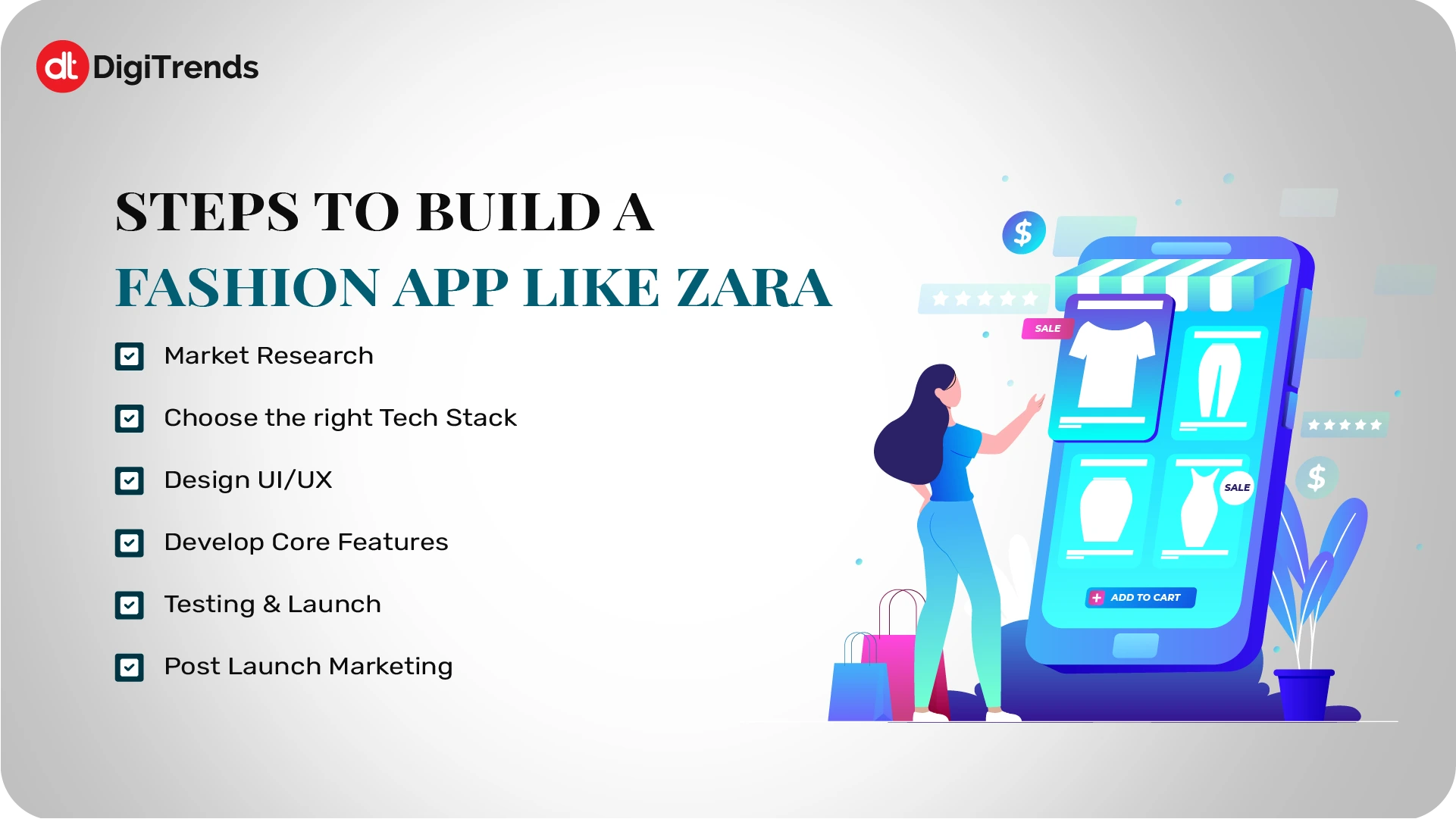
Identify your target audiences, their preferences, their demographics, and also their buying habits.
Take a deeper look at how well-known fashion retail apps like ASOS,handM, and Zara are doing, the benefits they offer, unique features they possess, and also analyze their drawbacks.
Keep an eye on the latest trends, like augmented reality try-ons and AI personalization als, as consumers are moving fast toward sustainability. Keeping these trends in mind will help you to stay ahead.
Identify the burning question or problem that frustrated the consumer,s, and you can solve that problem.
To create a seamless shopping experience for users, it is important to use frameworks like Flutter and React-Native.
Choose Node. Js or other scalable solutions. Js Django or Ruby on Rails to effectively manage user information and transactions.
To secure and maintain large data, fashion retail apps need to choose dependable databases.
Offer preferable customer payment methods like cash on delivery and delivery via channels like PayPal, stripe, or bank account. Just to facilitate the customers.
Leverage tools like TensorFlow, AR core, or AR kit to develop augmented reality and AI features. These tools help to give personalized suggestions and solutions.
To see the design and functionality of the app, make wireframes and prototypes. A wireframe is a visual depiction of your program structure and functionality. It will help you arrange your app’s user interface and user experience.
Create an intuitive UI with search options, filters, and menus that are simple to use.
Employ top-notch photos, dependable branding, and a contemporary color palette to produce a captivating fashion app design.
Put features like voice commands and scalable text sizes into the app to make sure it works for everyone,e including people with disabilities.
Integration of mobile commerce in fashion apps allows users to easily browse items in their carts and make purchases.
Use machine learning algorithms to generate dynamic content and personalized product recommendations.
Use augmented reality to visualize products or create virtual changing rooms
Make sure users can view precise stock levels and get alerts when supplies are running low.
Permit users to post reviews, purchases, and products on social media.
Create gamification elements, reward programs, and discounts to promote recurring business.
Ensure that all features, including search filters, payment gateways, and AR try-ons, function as intended.
Encryption, secure authentication, and adherence to data protection laws can all help safeguard user data.
Make sure the app is optimized for seamless device performance and quick loading times.
It involves a small group of testers before launching the final product. Testers will provide feedback, and based on their input, bugs can be fixed, and thus performance can be improved.
To increase your app’s visibility in app stores, make sure the title description and keywords are optimized.
With more than half of the world on social media, it makes sense to launch a campaign for your product on different social media channels such as Facebook, TikTok, Instagram, Pinterest, etc.
To promote your app to a wider audience, consider influencer marketing, those influential people you to reach your target audience and also help in downloading the app.
Employ search ads, display ads, and social media ads to reach your target audience.
Build an email list and send them marketing messages to build customer loyalty or encourage them to purchase.
User engagement can be increased by promoting user-generated content and by taking their reviews and recommendations into your marketing strategy.
Release updates frequently and keep an eye on analytics and user feedback to pinpoint areas that need work.
White-label solutions offer pre-made mobile applications that can be rebranded and tailored for various businesses. These solutions offer necessary features like push notifications, secure payments, and product catalogs while also saving money and time. Thanks to platforms like Tapcart, Vajro, and Shopify Shop App, fashion brands can introduce mobile apps with little development work. Businesses who are looking to create a branded mobile shopping experience will find this perfect.
Users can create mobile apps with drag-and-drop tools on no-code and low-code platforms without using programming skills. These platforms, like Adalo, Bubble, and Glide, offer design and functional flexibility,y which makes them appropriate for small businesses and fashion startups. They are ideal for people who want to test an app concept before spending money on full development or who are looking for an affordable fashion app development solution.
With the help of integrated mobile app extensions offered by numerous e-commerce platforms, companies can easily transform their online stores into mobile apps without knowing about Coding. Users can handle marketing, sales, and inventory from a single platform with the help of integrations provided by Shopify, WooCommerce, and Magento. Businesses that already have an online store and wish to reach mobile users without developing a separate app will find these solutions ideal.
Web-based apps known as PWAs offer a mobile app-like experience without the need to download them from app stores. They have fast loading times, offline functionality, and features like home screen installation and push notifications. Businesses that have successfully used PWAs to improve their mobile shopping experiences include Zara and AliExpress. For companies seeking an affordable way to offer a seamless mobile experience without maintaining separate Android and iOS apps, PWAs are a great substitute.
Companies can list their goods on well-known marketplaces like Amazon, Etsy, Zalando, and ASOS Marketplace rather than creating a fashion app. These platforms offer a pre-made audience as well as integrated e-commerce features like customer service and safe payment processing. For brands looking to boost sales without spending money on app development or marketing a stand-alone application, this is the best choice.
For fashion retail apps like Zara, consider hiring a mobile app development company like DigiTrends, which has years of expertise in developing e-commerce apps and delivering exceptional results while ensuring the app meets specific business requirements. This approach works best for well-known brands seeking a distinctive, high-quality app with features that align with their needs and seamlessly integrate with their business strategy.
Making a fashion app is a thrilling yet difficult process with many obstacles. To create a successful app, brands need to address some issues, including security and user experience. The main issues in developing fashion apps are listed below, along with solutions.
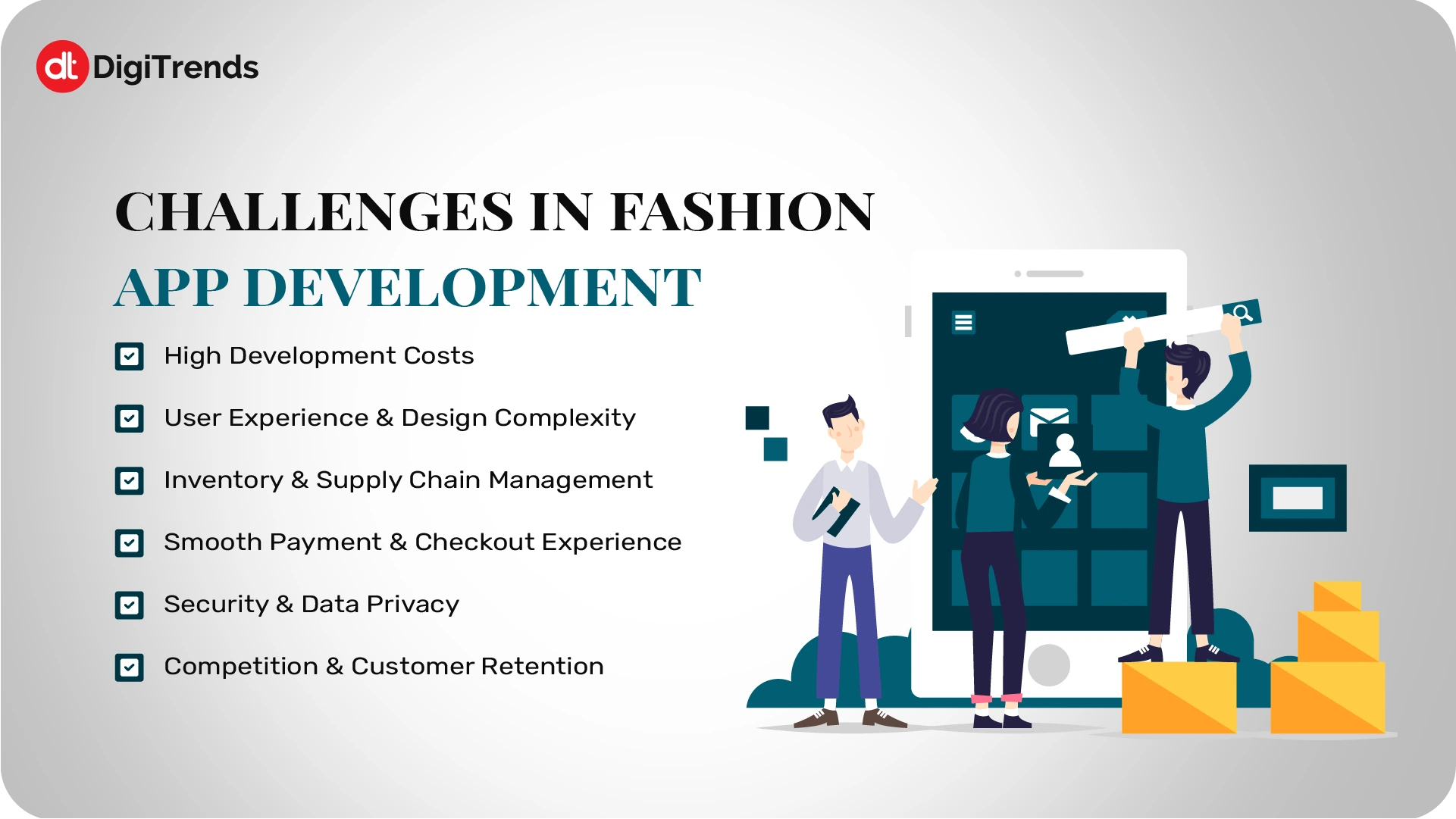
Expensive development costs. Making a fashion app from scratch involves a huge investment in backend development, security maintenance, and UI/UX design. Employing qualified developers and making sure everything runs smoothly can be costly.
Solution:
Businesses can cut expenses by using progressive web apps (PWAs), white-label solutions, or no-code platforms in place of custom development. Working with a skilled development company can also help to keep costs down and expedite the process.
An interface that is both visually appealing and easy to use is essential for fashion apps. High bounce rates can result from user annoyance caused by cluttered layouts, poor navigation, or slow load times.
Solution:
Invest in high-quality graphics, responsive design, and easy navigation. Customizing recommendations according to user preferences is another way that AI-driven personalization can improve the shopping experience.
It can be challenging to prevent overselling, manage inventory in real-time, and guarantee seamless stock updates, particularly for brands that work with several suppliers.
Solution:
Include an automated inventory management system that communicates with suppliers and warehouses. Stock updates can also be made more efficient by utilizing cloud-based programs like Magento, WooCommerce, or Shopify.
A convoluted checkout procedure or a dearth of preferred payment methods may cause customers to abandon their carts.
Solution:
Include several safe payment gateways such as digital wallet, PayPal, Apple Pay, and credit cards. Use autofill features and allow guest checkout to expedite transactions.
Fashion applications need to safeguard user data, payment information, and personal information due to the increase in cyber threats.
Solution:
Put two-factor authentication (2FA) SSL encryption and adherence to the GDPR or other data privacy laws into practice. Frequent updates and security audits are also required.
The fierce competition in the fashion industry makes it challenging for new apps to acquire users and keep them as customers.
Solution:
Make use of individualized recommendations, specific discounts, and loyalty programs. Social media marketing influencer collaborations and interesting content can all aid in drawing in and keeping users.
The fashion app landscape is adopting change and incorporating new emerging technologies like AR/VR, AI personalization, gamification, etc.
Here’s a closer look at how these trends are impacting the market and how you can use them to develop a fashion app that is both competitive and easy to use.
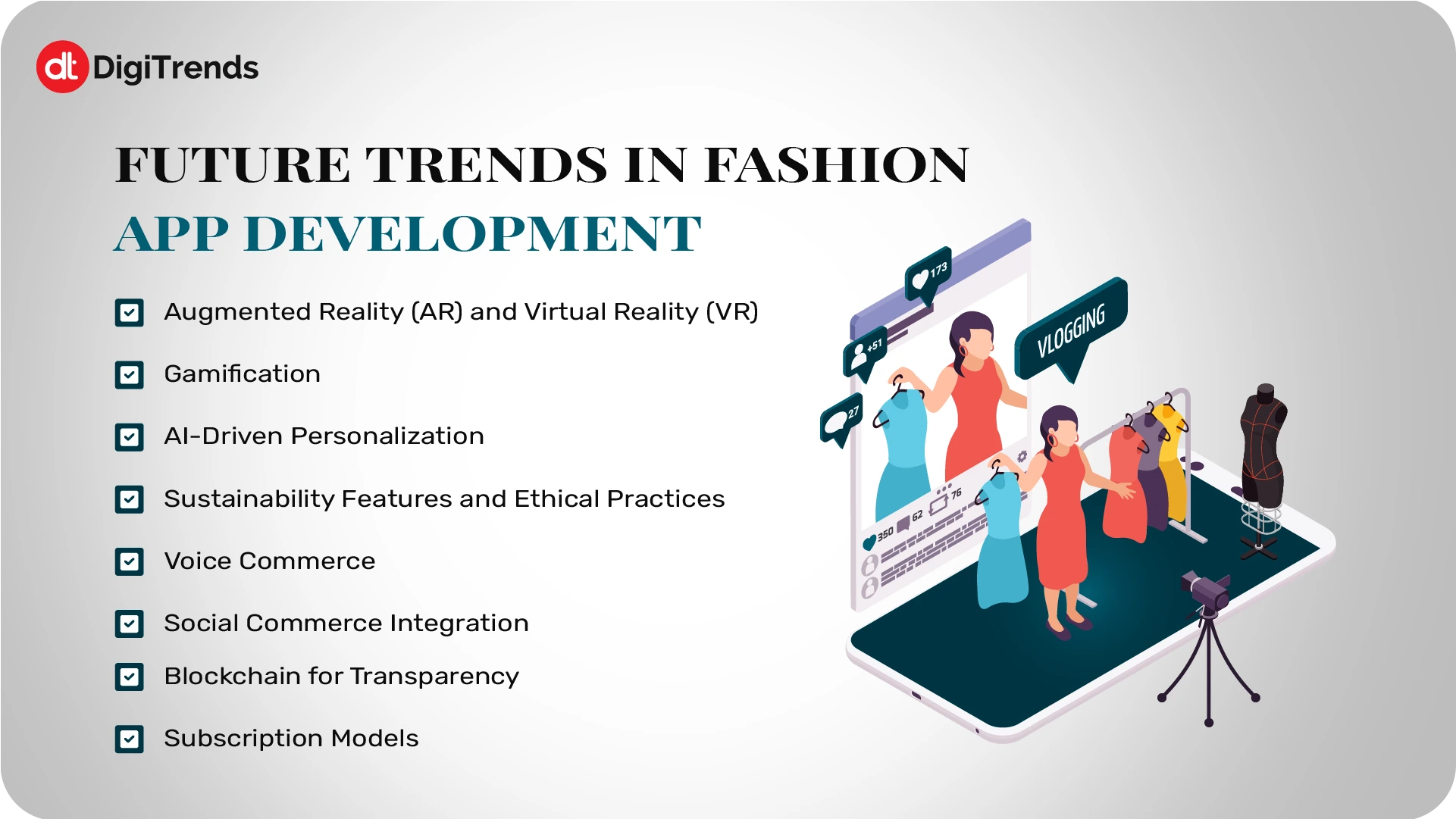
Virtual fitting rooms and 3D product displays are set to become standard features in fashion app design, allowing users to visualize products before purchasing. According to Deloitte, brands utilizing Augmented Reality (AR) and Virtual Reality (VR) technologies can expect to see a 40% decrease in return rates and a 25% increase in conversion rate.
Gamification in fashion retail is turning the way how brands used to engage with consumers. By incorporating game-like elements like points, rewards, challenges, and leaderboards, fashion retailers can make the shopping experience more enjoyable.
Apps need to include features that highlight eco-friendly products, carbon footprint tracking, and recycling programs to appeal to environmentally conscious consumers. Because consumers are more conscious now of environmental and ethical issues. A 2018 survey conducted by the consulting firm Futerra revealed that 88% of consumers want brands to help them be more environmentally and ethically conscious. This indicates a strong consumer demand for companies to engage in sustainable and ethical practices.
Voice commerce, or V-Commerce, uses voice search to facilitate the consumer. With virtual assistants like Alexa and Google Assistant, consumers can do shopping with just their voice commands. It is a nice to have feature for mobile commerce apps.
To create a seamless shopping experience, a strong online media presence is very important because it allows users to shop directly through social media platforms without leaving the app. Instagram checkout and TikTok shopping are examples of social commerce integration.
Blockchain technology in fashion refers to offering solutions to counterfeiting, supply chain management, and ethical sourcing. The integration of blockchain in fashion enables the building of trust and authority by providing transaction records.
Subscription-based services, such as rental fashion or exclusive member perks, will become more popular in fashion retail apps. This helps to generate steady revenue. These programs offer exclusive benefits like early access to new collections, personalized experiences, repeated purchases, and deep customer relationships.

These were the prerequisites to develop a fashion eCommerce app that is comparable to Zara. With consistent work and marketing strategies, your retail company can create a successful fashion app like Zara. Finding the best mobile app development company that provides you with the latest technology and cutting-edge algorithms to help you grow and expand your business globally requires a thorough investigation.
Employ DigiTrends for eCommerce app development services to realize your goals and turn them into a reality.
1. What is the expected growth of the mobile commerce market?
2. What features made Zara’s app successful?
3. What are the essential features of a successful fashion app?
4. What steps are involved in building a fashion app like Zara?